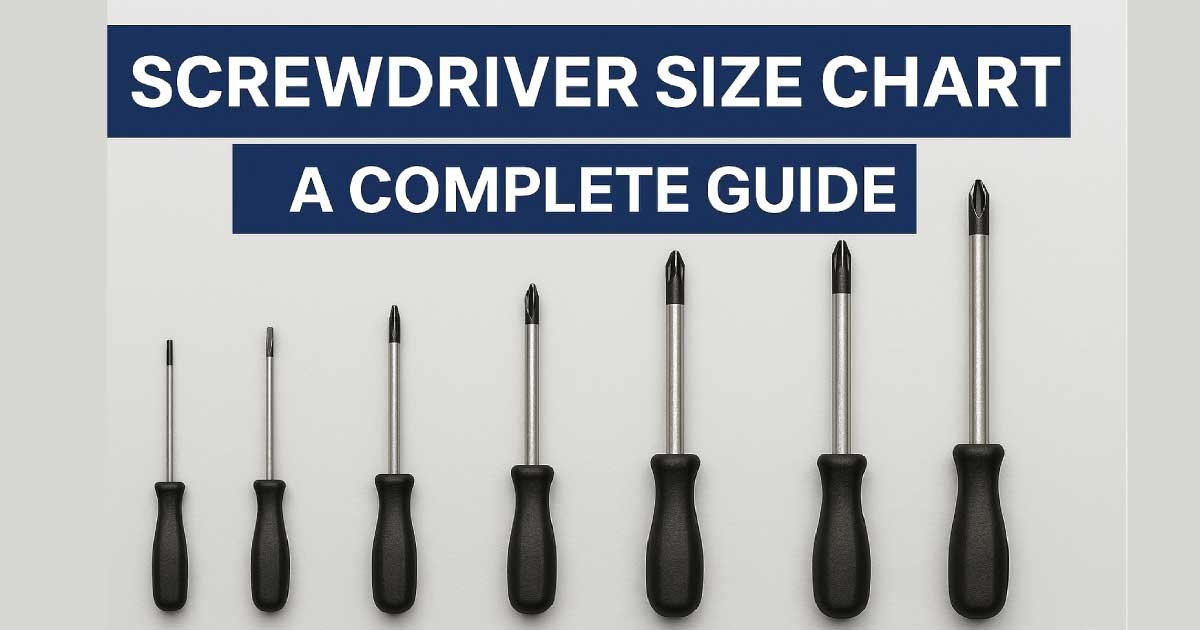When it comes to DIY projects, automotive repair, home maintenance, or even assembling furniture, a screwdriver is one of the most commonly used tools. But not all screwdrivers are the same. They come in different types, shapes, and sizes—and choosing the right one makes a big difference in safety, efficiency, and the quality of your work.
That’s why having a screwdriver size chart is so important. It helps you identify the correct tool for the correct screw head, reducing the risk of damaging screws or tools.
In this complete guide, we’ll cover:
What a screwdriver is and why size matters
The different types of screwdrivers
A complete screwdriver size chart (flathead, Phillips, Torx, and more)
Common uses for different sizes
Tips for choosing the right screwdriver
Maintenance and storage advice
Why Screwdriver Size Matters
At first glance, it might seem like any screwdriver can work on any screw, but using the wrong size can cause several problems:
Stripping the screw head (making it unusable)
Slipping and injury risks
Damaging the tool
Wasting time because the tool doesn’t grip properly
The correct screwdriver ensures a tight fit, good torque, and safety.
Common Types of Screwdrivers
There are dozens of screwdriver types, but the most common ones are:
Flathead (Slotted) Screwdriver
Straight, flat blade
Common in woodworking, appliances, and older hardware
Phillips Screwdriver
Cross-shaped tip
Designed to prevent over-tightening by camming out
Widely used in electronics, furniture, and vehicles
Torx Screwdriver
Star-shaped tip
Popular in electronics, automobiles, and bikes
Provides excellent torque without slipping
Hex Screwdriver
Hexagonal tip (like a built-in Allen key)
Used in bicycles, machinery, and furniture
Pozidriv, Robertson, and Specialty Screwdrivers
Pozidriv: Similar to Phillips but with extra lines for grip
Robertson: Square drive, common in woodworking and Canadian tools
Specialty: Tri-wing, spanner, clutch head, used in electronics and security screws
Screwdriver Size Chart
Below are screwdriver size charts for the most commonly used types.
Flathead (Slotted) Screwdriver Size Chart
| Blade Width | Shaft Diameter | Common Uses |
|---|---|---|
| 2.0 mm (3/32″) | 1.5 mm | Small electronics, eyeglasses |
| 3.0 mm (1/8″) | 2.0 mm | Small appliances |
| 4.0 mm (5/32″) | 2.5 mm | Household items |
| 5.5 mm (7/32″) | 3.0 mm | Furniture, electrical outlets |
| 6.5 mm (1/4″) | 3.5 mm | Automotive, general repairs |
| 8.0 mm (5/16″) | 4.0 mm | Machinery, heavy-duty screws |
| 10 mm (3/8″) | 6.0 mm | Industrial equipment |
Phillips Screwdriver Size Chart
| Phillips Size | Shaft Diameter | Common Uses |
|---|---|---|
| #000 | 1.5 mm | Precision electronics, watches |
| #00 | 2.0 mm | Eyeglasses, small devices |
| #0 | 2.5 mm | Electronics, small appliances |
| #1 | 3.0 mm | Household items, small screws |
| #2 | 4.0 mm | Most common size, furniture, automotive |
| #3 | 5.0 mm | Larger screws, machinery |
| #4 | 6.0 mm | Heavy-duty construction, industry |
Torx Screwdriver Size Chart
| Torx Size | Drive Diameter (mm) | Common Uses |
|---|---|---|
| T1 | 0.81 mm | Precision electronics |
| T2 | 0.93 mm | Phones, small gadgets |
| T3 | 1.10 mm | Laptops, cameras |
| T4 | 1.30 mm | Electronics repair |
| T5 | 1.42 mm | Hard drives, tablets |
| T6 | 1.70 mm | Small appliances |
| T8 | 2.31 mm | Game consoles, bikes |
| T10 | 2.74 mm | Automotive, appliances |
| T15 | 3.27 mm | Automobiles, motorcycles |
| T20 | 3.86 mm | Furniture, vehicles |
| T25 | 4.43 mm | Bicycles, tools |
| T30 | 5.52 mm | Heavy-duty screws |
| T40 | 6.65 mm | Industrial, automotive parts |
Hex Screwdriver Size Chart
| Hex Size | Metric Equivalent | Common Uses |
|---|---|---|
| 1/16″ | ~1.5 mm | Electronics, small bolts |
| 5/64″ | ~2.0 mm | Small appliances |
| 3/32″ | ~2.5 mm | Bicycles, furniture |
| 1/8″ | ~3 mm | Furniture assembly |
| 5/32″ | ~4 mm | Automotive, bicycles |
| 3/16″ | ~5 mm | Machinery |
| 1/4″ | ~6 mm | Automotive engines |
Most Common Screwdriver Sizes You’ll Use
Out of all the possible options, here are the screwdriver sizes you’ll encounter the most in daily projects:
Flathead 4.0 mm (5/32″): Used in outlets, furniture, and appliances
Phillips #2: The universal screwdriver size for household and automotive work
Torx T10 & T25: Found in bikes, vehicles, and electronics
Hex 3 mm to 5 mm: Common in furniture assembly and bicycles
If you only want a starter set, make sure it includes:
Flathead: 3 mm, 5.5 mm, 6.5 mm
Phillips: #0, #1, #2
Torx: T6, T10, T25
Hex: 3 mm, 4 mm, 5 mm
Tips for Choosing the Right Screwdriver
Match the tip to the screw head exactly. A loose fit will strip the screw.
Choose the right handle design—ergonomic or T-handle screwdrivers provide more torque.
Use precision screwdrivers for electronics and delicate items.
Consider magnetic tips to hold screws in tight spaces.
Get a full set with both metric and imperial sizes for versatility.
Maintenance and Storage
To make your screwdrivers last longer:
Clean after use to remove grease and dirt.
Store in a case or toolbox to avoid rust and losing sizes.
Avoid using screwdrivers as prying tools—they’re made for screws only.
Inspect tips regularly—replace worn or bent drivers.
Final Thoughts
A screwdriver size chart is more than just a list—it’s a guide that ensures you’re always prepared for any project. Whether you’re repairing electronics, tightening a bike, assembling flat-pack furniture, or working on a car, having the correct screwdriver size saves time, prevents damage, and improves safety.
The next time you pick up a screwdriver, remember: the right size equals the right result.
Here’s our newest post:

